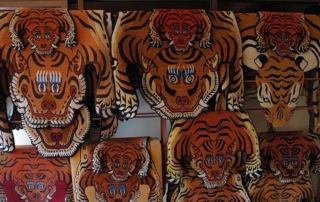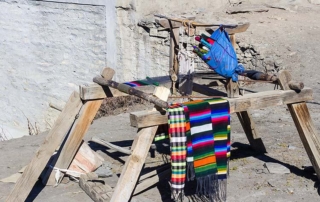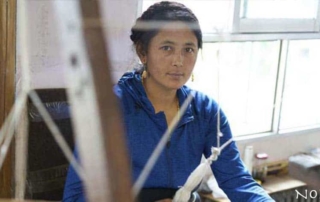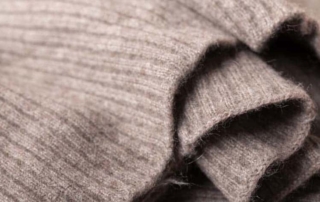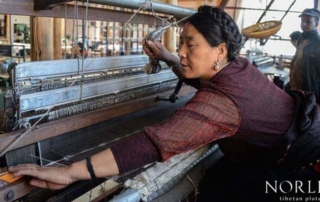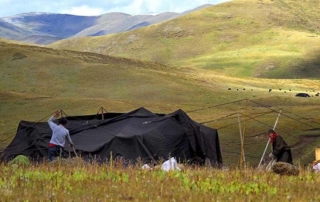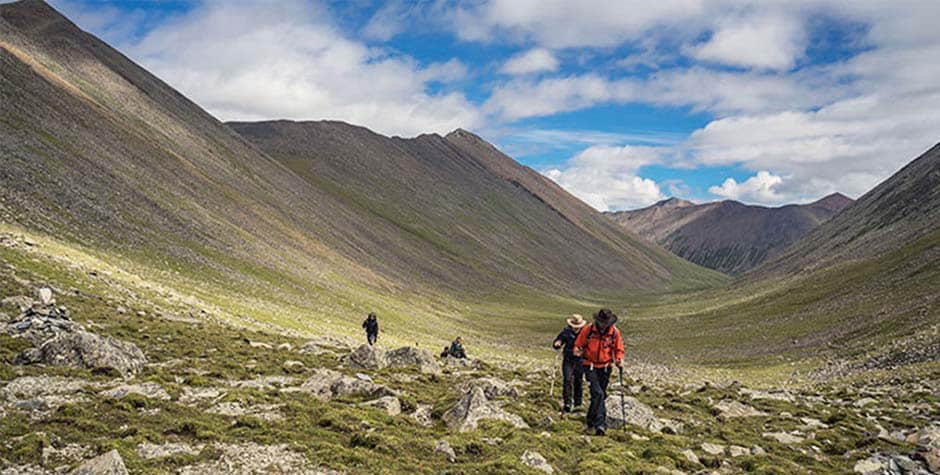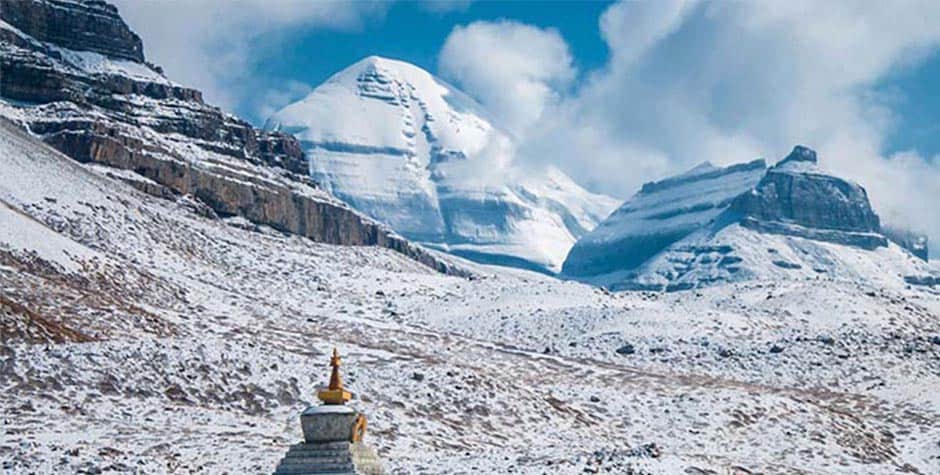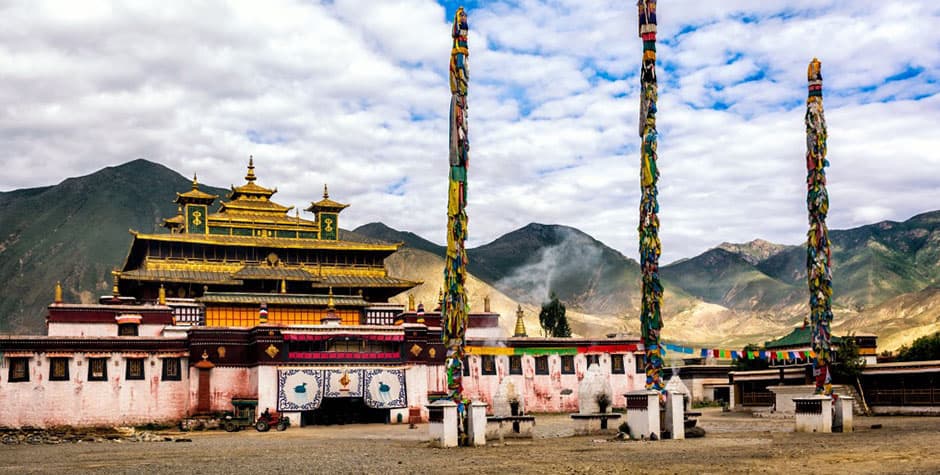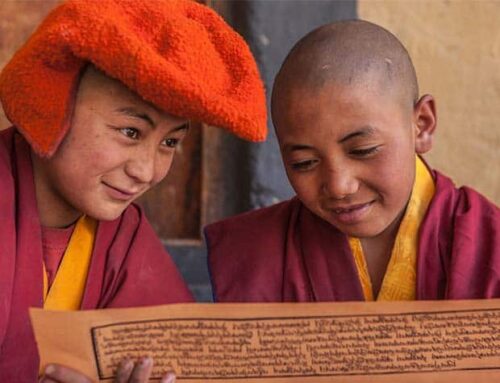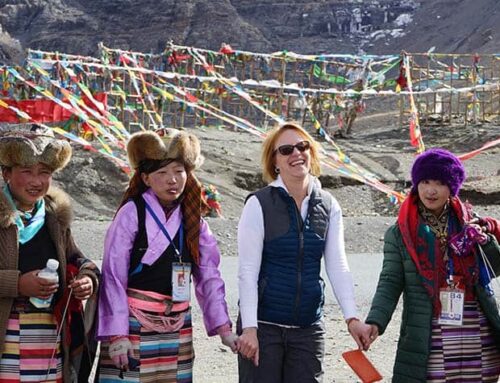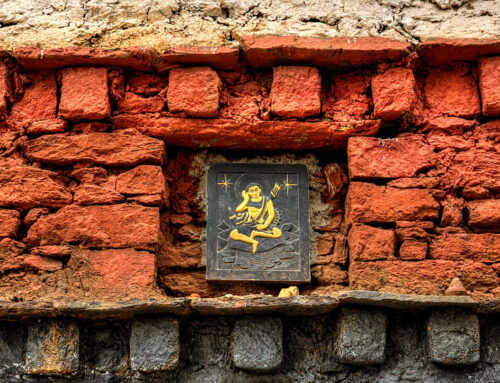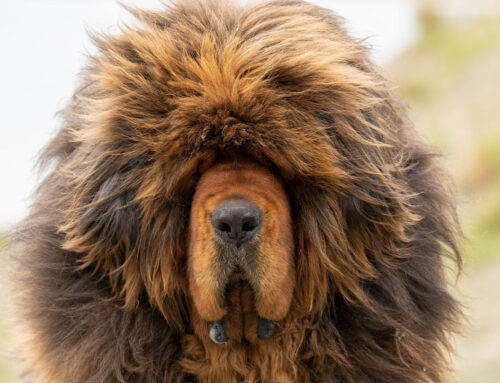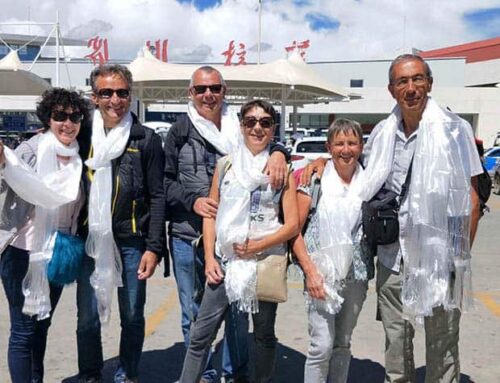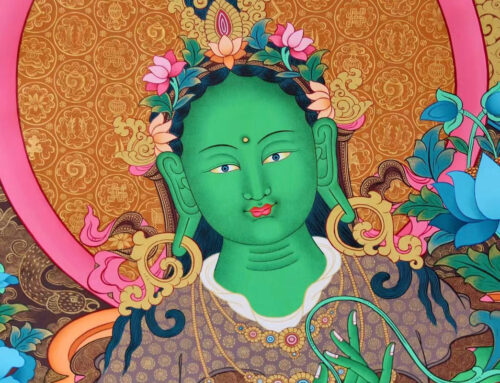Tibetan weaving history is long and prosperous. We have developed our unique method of weaving. The historian can trace Tibetan weaving to the 7th Century.
What is so interesting about Tibetan weaving is that we have developed a unique way of making clothes and rugs that is entirely different from any other surrounding regions. In Tibet, we use local wools from the Yak and Sheep for weaving. We have produced different varieties of clothes and rugs for over a century.
History of Tibetan Weaving
Many historians believe Princess Wencheng first introduced weaving in Tibet in the 7th century. Tibetan King Songtsan Gampo wants to add many skills from other parts of China, Nepal, and India to make life in Tibet more progressive. His wife from the Tang Dynasty has helped introduce many arts and skills into Tibetan Society, and Weaving is one of the professions she helped introduce in Tibet.
Tibetan weaving technique has been well established, and it does not appear to be influenced by other well-established regions, such as Persian and other parts of China. Here in Tibet, weaving was done out of necessity, and weavers created rugs such as saddle covers, curtains for the window, sleeping mats, and other utility purposes. Besides exceptions of royalty, high lamas, and aristocratic families, Tibetan weaving is not for elegance and decoration. Clothes and rugs are usually produced for household use and never meant for selling and export, so old Tibetan clothes and carpets are hard to find.
In old times, Tibetan clothes and rugs were often woven in three basic sets of design: a primary and Simple design for household consumption, a Tiger design, and an Elegant Design with the influence of Chinese design. In the old days, we had minimal access to dyes, which is why Tibetan clothes and rugs were straightforward in design and Color. The more elegant design takes influence from Chinese Design, using images such as dragons and lotus flowers.
One unique Design in Tibet is the Tibetan Tiger rug. These mats are for Lamas as prayer mats. In Tibetan Buddhism, the Tiger is revered, and it is believed to protect them during practice and meditation.
Sociological Background of Tibetan Weaving
Most households in traditional Tibet are self-sustaining and often produce what they need in their home. The man in the family is considered the Outer wall of the family. The man would go out to look after the animals, do the business outside, and look after the field. Women are considered the inner pillar of the family. She would look after the children, Milk the Dri (female of a yak, and yaks are male). Often, in her free time, she would weave clothes and rugs for the family. The wool used in weaving is usually from Domestic yaks and Sheep.
The skills of the craft of weaving are passed down from generation to generation. The bride must often know all these skills before marrying into the husband’s family. The family size is enormous since all the traditional Tibetan families are joint families. Hence, the bride would require an excellent weaver. The Husband and parents of the husband’s family would often show off the outstanding work done by their new bride during the social gathering and Tibetan New Year, which is why the bride needs to learn these skills before marriage. You can read more about Tibetan marriage here.
In old Tibet, our Tibetan society was estate-based. Many villages and Nomads often belong to the aristocratic family in Lhasa. If the family belongs to a particular estate, the family members have to o their master’sster hold to pay their tax in service along with other taxes. Hence they will have to go and make those elegant clothes and rugs for their master’s family in Lhasa and other bigger cities.
Gyantse is one of the estates where the clothes and rugs are mass-produced for the Regional Tibetan government in Lhasa and most of the most significant monasteries in Tibet. Here, the slaves work to produce enough to supply these demands.
Clothes Weaved in Tibet
Most clothes are made with wool from Yaks and Sheep. Most garments are produced only for domestic consumption. Generally, there are five kinds of woolen clothes produced in Tibet. This differentiation is based on the finest of the clothes and their purpose.
Ba (སྦྲ་)
Ba is the thickest of all the clothes made in the Tibetan family. It is often used as the Nomad Tent and Outer curtain for the main buildings in the monasteries and Palaces, especially the Potala Palace in the Winter. One of the most prominent characteristics of the Ba cloth is that during the warm season, the fiber of the Ba loosens up and becomes breathable. In the cold winter and during the rainy season, the Ba fiber tightens up to block the cold air from coming into the structure.
Each nomad family would stay in a tent made of Ba. Another widespread use of the Ba is as the Outer curtain for the main building of Monasteries and Palaces. It helps protect against the cold winter wind and dust. It is also helpful to prevent Tibet’s Sun from fading the beautiful Tibetan wood painting works and the frames of the windows and doors.
Lüw (Tibetan Yak wool Blanket)
Every household in Tibet has Lüw, popularly known as the Tibetan Yak wool blanket. It is made at home and is very hard to find in the market. We must order it from relatives in Tibetan Villages if we want it. Most travel agencies use it during trekking in Tibet.
It is thick and heavy. Due to its heaviness, it is hot to wear above the standard blanket.
Tsuptruk
Tsuptruk is a Tibetan blanket that is traditionally used everywhere in Tibet. It is thick and heavy. The outer layer is smooth, and the inner layer is hairy. Unlike other clothes, Tsuptruk is not made yearly but is always made at home when a new one is needed. A Thick and heavy Tibetan blanket is traditionally used everywhere in Tibet. The outer layer is smooth, and the inner layer is hairy. Unlike other clothes, Tsuptruk is not made yearly but is always made in the home, like Lüw; Tsuptruk is usually unavailable in the market.
Nambu (སྣམ་བུ་)
Nambu is the most common fabric used in old Tibet to make dresses. It is a little thicker and easier to make. Since it takes less time, it is cheaper in the market and commonly used by ordinary people and monks to make their clothes. It is also used to make a Tibetan boot called Sumba. Since it is less refined and releases lots of hairs, it can only be washed to clean it. Nambu is used in Central Tibet to make aprons for the ladies, and it is also used for making Tibetan boots called sumba.
Nowadays, it is commonly used to make ladies’ handbags and gifts for tourists to buy as souvenirs. You can find many products made locally from the Nambu fabric.
Shedma (ཤད་མ་)
Shedma is the finest clothes woven with wool. It is so subtle that it takes a lot of labor to produce, so it is more expensive. It is only used by the well-off families to make their dresses. The high lamas and Aristocrats often use it since it is carefully woven. The texture of the Shedma is so soft and shiny to the touch. The value of the Shedma is generally based on the fineness, softness, and shine on the surface.
To keep the texture shiny, we would make a pak (dough of Tsampa) and roll it on the cloth to remove dust and other impurities from the fabric. Shedma is also used to make the apron for Ladies in the Lhasa region and Boots for higher and more affluent people.
Tibetan Rugs
Tibetan Rugs are the prevalent item among International travelers. During the early time in Tibetan tourism, Tibetan Rugs were in huge demand among International visitors.
As in Tibet, I don’t remember any family that does not use rugs. Traditionally, weaving clothes and rugs has been passed down from generation to generation. We often tell, we can judge, how well a family is doing by the quality of the Rugs in their home. So, having good rugs in the family is a status symbol in front of the visiting guests, especially during the Tibetan New Year and other social ceremonies. While visit the Nomad and Tibetan family in the Village, you will often see all the household members using a rug one bed.
Historians have different views on how Tibet has developed its unique style in weaving rugs. Some believe Persia influences it. The popular think that weaving carpets and clothes was brought to Tibet by the princess Wencheng in the 7th century when she married the Tibetan King Songtsen Gampo.
As time passes, we have developed our unique local ways and skills in weaving rugs, too. Tibetans made Rugs for different utility purposes: Mats for meditating monks, mats on the bed, Floor mats, window and door covers during the winter, and wall hangings.
The most popular Tibetan rugs in the modern market are Tibetan rugs. The tiger is a revered animal in Tibetan Buddhism. In the past, the monks only used Tiger rugs. It is believed that Tibet will protect them from Negative elements while they meditate or practice.
Another popular Tibetan rug is called Wangden Rugs. These loosely woven rugs have a lower knot count and a thicker pile than other Tibetan rug types. This type of carpet is used in monasteries as a sitting carpet in the assembly hall. Nowadays, this rug is made in the Wangden valley of Shigatse. The most popular place where you will find this carpet is at the 13th Daai Lama’s Quarater entrance in Potala Palace.
During your Tibet travel, we strongly recommend you visit the Tibetan Rug producer in the town of Gyantse, which has hundreds of years of history. If you are interested, we offer custom-made Tibet culture tours to visit Tibetan handicraft centers, Tibetan families in Villages, and Nomads.
The process of Weaving Tibetan Clothes and Rugs
Production of Tibetan Clothes and rugs is a very labor intensive and a very lengthy process. Traditionally it is all made with a bare hand. From getting wool from the Yaks and Sheep to the finish, the product could take many months and even a year in manufacturing. Which is why in the old times. A family member would take a turn each year to use the finished product.
-
Sorting wool and washing
The first step in the weaving is sorting the wool. First, they would handpick all the foreign elements like grass and woods. After the non-wool particle is picked, they would short the pieces of wool to be used in the different products. Finest wool will go for the production of Shedma, and thicker wool will go for the production of Ba and Rugs as per the product requirement. After the wools are sorted. It will be washed in warm water. Warm water helps to soften the wool and retain its character.
-
Wool carding
It is a process of combing the wool is the wool to separate the jointed wool and remove impurities, if any remains. Carding also helps make the wool soft ready to yarn. Carding comb is made with the wooden plank with metal needles.
-
Spinning
The next step in the Tibetan weaving is spinning. In this process, the wool is converted in Yarn using a simple tool of a wheel called Korlo. The wool is twisted into the desired thickness of the yarn. The selection of the Wool and thickness of the Yarn is decided as per the thickness of the product. If the weaving is for Shedma (Fine Clothes), They will make a very fine yarn. If the weaving is for the Rugs and Ba, They would thick hair and make the yarn thick.
-
Dyeing
After the spinning process, the yarns are set for dyeing. To ensure the best result from the dyeing process, the Yarns are wash one more time before the Dyeing. For dyeing, We used mineral and vegetable colors. The Most common and cheap color for dyeing is Black and maroon color. Which is the product of these colors are plenty and if you see an old picture of Tibet, you will every ordinary people are wearing maroon colored Chupa (robe). In the process of dying the yarn in cooked in a huge metal pot with the colored waters.
-
Weaving
To weave Ba, there is no requirement for any machine. Nomads and Villagers as set up the weaving thread with the minimum requirement and can be made in any space. It is not a very lengthy process too.
To Weave Shedma and Nambu, we used to draw loom which could be not more than the dimension of 1 meter each direction. The process of weaving could be long base on how excellent the final products need to be.
To weave Rugs, Tibetan weaver would use the weight loom. They follow the specific design pattern to use the different color yarn for images on the rugs. The most popular Tibetan rugs design is the Tibet Rug. Both processes need great craftsmanship.
After the rugs are weaved. The craftsmen would clip the edge of design using the scissors. This process makes the design visible and elegant look. Other surfaces would also be cut and smoothen using big scissors.
The rugs and cloth will be washed a few times after that to get the design shade and shape.
-
Stretching
After the clothes and rugs are finalize. It will be stretched from the four corners by four individuals. It helps to retain the perfect shape of the Rugs and Clothes. Nowadays they use the machine to do the stretching to better performance in stretching.
Read more about Tibet Travel Information and Tibet Tours. Please visit our blog: Nomadictibet.com
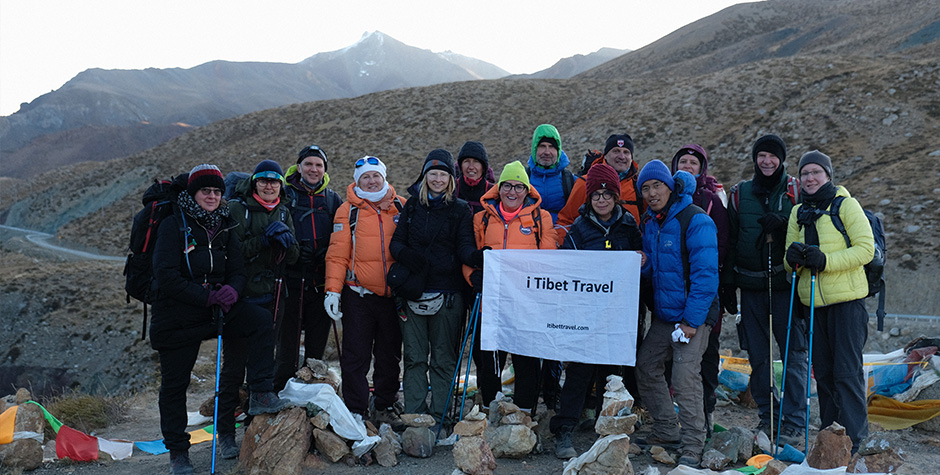
Tenzin Travel is the best Tibetan Travel agency in Tibet. Our agency is one of Tibet’s most experienced tour operators, with over 20 years in the industry. Founded by a local Tibetan family with decades of expertise as guides, managers, and route planners, we craft personalized itineraries for every traveler. We are the highest-rated and most recommended Tibet travel agency on TripAdvisor, Google, and LonelyPlanet.
We can make holistic arrangements for your trip to Tibet, including a Tibet Travel Permit, a Tibetan tour guide, flight tickets, train tickets, vehicle arrangements, and hotel bookings in Tibet.
Our Lhasa office is just steps from Barkhor Square, and our all-Tibetan team ensures deep cultural, linguistic, and religious insights, setting us apart from other agencies.
Beyond tourism, we support Tibetan communities by donating a portion of each tour to local projects. Your travel to Tibet is about more than profit—it’s about the opportunity for us to give back.

